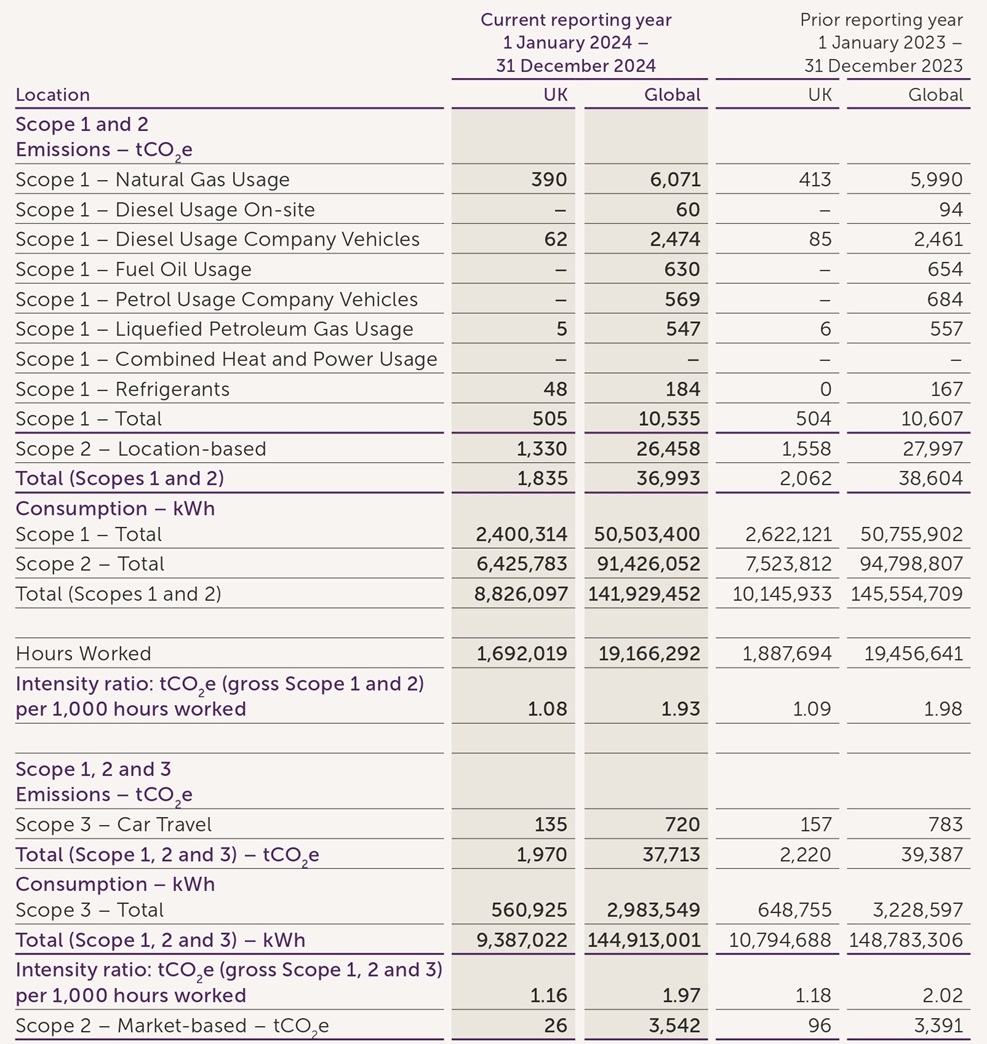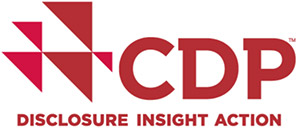Overview
We are dedicated to reducing our carbon footprint and environmental impact through global initiatives aimed at enhancing site efficiency, sharing best practices, and committing to year-on-year reductions. In 2024, we planned, progressed, or completed environmental initiatives targeting energy, water, waste, single-use plastic, hazardous material, renewable energy generation, and heat recovery.
We monitor and report our environmental performance at monthly Executive meetings, ensuring a focus on continuous improvement. Our ambitious goal is to halve our CO2 intensity by 2030, using 2019 Scope 1 & 2 GHG emissions as our baseline.
Key 2025 priorities
1. Decarbonising our sites and operations
2. Reducing our water withdrawal and nonrecycled hazardous waste
3. Supply chain management
Sustainability leadership
We have dedicated sustainability leads and Environmental Champions at every manufacturing site. This approach helps us develop and share best practices, monitor performance, and communicate initiatives via our internal platform.
Environmental
Carbon disclosure
The below table and supporting narrative summarise the Streamlined Energy and Carbon Reporting ('SECR') disclosure in line with the requirements for a quoted company, as per The Companies (Directors’ Report) and Limited Liability Partnerships (Energy and Carbon Report) Regulations 2018.

Note that this data excludes the recent acquisition of TWTG. We will include TWTG’s figures in our next update (2025).
We calculate our GHG emissions estimates to cover all material sources of emissions from the operations for which we are responsible. The methodology used is the GHG Protocol: A Corporate Accounting and Reporting Standard (revised edition, 2015). Responsibility for emissions sources is determined using the operational control approach. All emissions sources required under The Companies (Directors’ Report) and Limited Liability Partnerships (Energy and Carbon Report) Regulations 2018 are included.
The scope of emissions covers the following sources: natural gas, fuel oil, liquefied petroleum gas (‘LPG)’, diesel, petrol, combined heat and power (‘CHP’), electricity and business travel in employee-owned or hire vehicles.
The UL 360 Sustainability Software GHG (Greenhouse Gas) emission tool was used to calculate and consolidate the Scope 1 & 2 emissions adopting a location-based and market-based approach. The tool used the following conversion factors: Scope 1 – UK Government’s GHG Conversion Factors used for all sites. Scope 2 – UK Government’s GHG Conversion Factors are used for UK sites and the International Energy Agency’s (‘IEA’) conversion factors are used for non-UK sites.
In addition, for our market-based calculations, the Reliable Disclosure (‘RE-DISS’), AIB European Residual Mixes and Green-e are used. Our reported Scope 3 emissions were calculated by converting mileage into emissions using UK Government’s GHG Conversion Factors for Company Reporting.
Our carbon reporting statistics demonstrate that our recent performance of tCO2e has continued to improve. On a like-for-like basis, we achieved our target to keep emissions below 2019 levels for 2024. The Scope 1 & 2 data in our SECR table has been externally verified by Ricardo Energy & Environment, who performed a limited-level verification review in accordance with the requirements of ISO 14064-3 and the GHG Protocol Corporate Standard. Of the 2024 total: our direct Scope 1 emissions of tCO2e (in essence gas, diesel and fuel oil consumed) amounted to 10,535 tonnes; and our indirect Scope 2 emissions of tCO2e (in essence the emissions generated on our behalf to provide our electricity) amounted to 26,458 tonnes. The emissions total represents a 36% reduction compared to 2019 for Scope 1 & 2.
We report the intensity metric of gross tCO2e per 1,000 hours worked as a unit of comparison to reflect our operational performance compared to carbon output as we feel this provides a more reflective measure of emissions versus our factory production activity. Our 2024 intensity ratio based on Scope 1 & 2 emissions is 1.93 tCO2e per 1,000 hours worked. This compares to our 2019 baseline of 2.78 tCO2e per 1,000 hours worked. We are on track to achieve our target of 1.39 tCO2e per 1,000 hours worked (50% of the 2019 baseline intensity) by 2030.
Scope 3 emissions
Our 2024 Scope 3 assessment has been conducted using a combination of volume data, spend data, and standard estimation techniques. Recognising the importance of data accuracy, we have been working to improve data quality and collection. Our assessment follows methodologies specified by the Greenhouse Gas Protocol and the UK’s Environmental Reporting Guidelines. Enhancing our data and disclosure involves collaboration with suppliers and a focused approach from our supply chain teams.
Our Scope 3 inventory was calculated using the Greenhouse Gas Protocol Corporate Value Chain (Scope 3) Standard. Categories 8, 10, and 13-15 are not applicable to us and were not quantified. This inventory has not been externally verified, but we plan to address this in 2025. The largest Scope 3 category is purchased goods and services, accounting for 77% of total Scope 3 emissions.
In addition to our Scope 1 & 2 targets, we have committed to a 25% reduction in Scope 3 emissions by 2030, which has been approved by the SBTi. We continue to focus on understanding product emissions, materials traceability, and supplier engagement. Product innovation and improving our efficiency remain key areas for us.
The Scope 3 table excludes data from the TWTG acquisition. This will be included in our next update (2025).
CDP
We continue to report our environmental disclosure on climate change and water security to CDP, maintaining our B Climate and improving our Water score to B-.

Please click here to view IMI’s latest CDP submission.
TCFD
We recognise the scale of the climate change imperative, which presents both risks and opportunities for our growth strategy and transition in line with our SBTi commitments. Our growth is driven by our ability to innovate, helping our customers and their end markets reduce their carbon footprint. We have set ambitious targets and received approval from the SBTi in 2024.
Our transition planning approach focuses on:
– Detailed emissions reduction pathways
– Technology, energy and product solution investment roadmaps
– Capital allocation strategies
– Supply chain engagement
– Climate-related risk management
A three year history of our environmental data can be downloaded here
Download our 2024 TCFD Disclosures
Air emissions
Managing air emissions is part of our environmental system. We comply with various environmental regulations and plan to create an air emission inventory for all sites. This will help us set reduction targets and enhance our reporting activities.
Decarbonising operations
We focus on decarbonising our operations, with solar panels at 17 locations generating 6,082 MWh of renewable energy in 2024. 24 of our 49 manufacturing facilities are ISO 14001 certified, and 4 are ISO 50001 certified. We purchased renewable energy certificates covering 89% of our electricity consumption in 2024. We will continue investing in renewable energy in 2025.
Scope 3 emissions
Our 2024 Scope 3 assessment has been conducted using a combination of volume data, spend data, and standard estimation techniques.
Recognising the importance of data accuracy, we have been working to improve data quality and collection. Our assessment follows methodologies specified by the Greenhouse Gas Protocol and the UK’s Environmental Reporting Guidelines. Enhancing our data and disclosure involves collaboration with suppliers and a focused approach from our supply chain teams.
Our Scope 3 inventory was calculated using the Greenhouse Gas Protocol Corporate Value Chain (Scope 3) Standard. Categories 8, 10, and 13-15 are not applicable to us and were not quantified. This inventory has not been externally verified, but we plan to address this in 2025. The largest Scope 3 category is purchased goods and services, accounting for 77% of total Scope 3 emissions.
In addition to our Scope 1 & 2 targets, we have committed to a 25% reduction in Scope 3 emissions by 2030, which has been approved by the SBTi. We continue to focus on understanding product emissions, materials traceability, and supplier engagement. Product innovation and improving our efficiency remain key areas for us. The Scope 3 table excludes data from the TWTG acquisition. This will be included in our next update (2025).
IMI in Action
Welcoming our new cohort of Future Leaders
We believe developing the leaders of tomorrow means building more than technical skill. It’s about cultivating curiosity, adaptability, and purpose. It means trusting early talent to contribute from day one – giving them the tools, exposure, and support to thrive.
Innovation grounded in close customer partnerships
Our partnership approach breaks through problems and reduces complexity. We don’t invent in isolation – we collaborate with our customers. We listen closely and we think differently, creating space for diverse minds to innovate.
Unlocking your potential
Alongside unifying our visual identity, we have unified the employee experience; creating an environment that combines care, curiosity, and impact – where our people can make a real difference by nurturing and empowering them both in their work and beyond.
